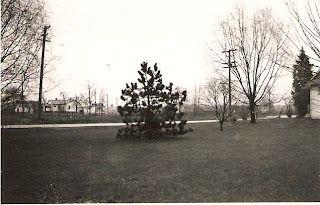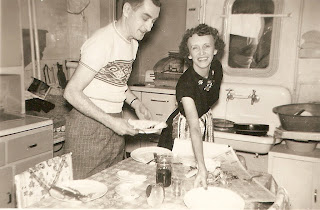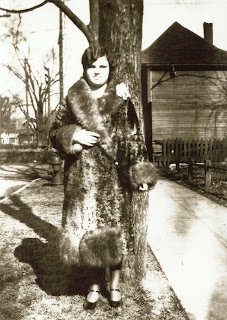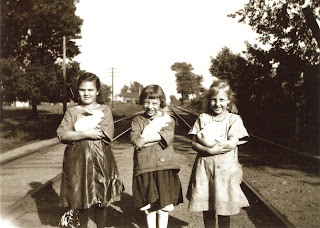The Vollrath brothers loved baseball and spent many hours playing the game. They practiced in a large empty lot just south of their home at 218 South Audubon Road. Charles and Marie Vollrath did not own the lot, but the kids were allowed to play there. In 2012, two small homes constructed in 1950 now sit on the large plot.
In the top photo, two Vollrath brothers play catch in the backyard of 218 South Audubon Road. In the other two pictures, the brothers warm up before a big game in the side lot. You can see the doubles, constructed in the early 1920s, across the street. The historic images are courtesy of Dr. Victor Vollrath, who spent many hours playing baseball here as a child.
Sunday, April 29, 2012
Saturday, April 28, 2012
The Pony of South Audubon Road--1928
Dandy lived in a small barn on the Vollrath lot at 218 South Audubon Road. The pony became a fixture for those who lived in southern Irvington as usually one or possibly two Vollrath children went for a stroll. In these historic photos, Victor Vollrath attempts to do tricks with the pony on a sidelot just south of the Vollrath home. The doubles visible across the street were relatively new when this photo was taken as builders only completed the dwellings in the early 1920s. A contemporary image shows those same structures in 2012. The historic image is courtesy of Dr. Victor Vollrath.
Friday, April 27, 2012
Reprieve for Historic Building!
The former Irvington Post Office and Hook's Drug Store has been taken off the docket for the hearing on May 2, 2012, at the Indianapolis Historic Preservation Commission. Tharp Investments has asked for another continuance because they are attempting to sell the building to an interested buyer. While nothing is definite, this is welcome news for this corner of Irvington. The company had originally asked for permission to demolish the historic structure. If the deal falls through, they may yet make that request possibly in June. More details will be posted as they become available.
Thursday, April 26, 2012
Vollrath Children Pose on Front Porch--1912
Lawrence, Irma, and Carl Vollrath pose on the front porch at 218 South Audubon Road in 1912. The family had only lived in the house for a few years when this photo was taken. Charles A. Vollrath and Thermina "Marie" Vollrath had the home constructed in 1909. This front porch would become the site of countless other family photographs throughout their fifty-year time span of living in the home. The children are dressed in their finest so perhaps it was a special day. This historic image is courtesy of Dr. Victor Vollrath, a younger brother to these three siblings.
Wednesday, April 25, 2012
Vollrath Children--1919
Lawrence, Irma, Carl, Hansen, and Victor Vollrath posed in the Irving Circle in 1919. Barely visible in the background was the home and office of Dr. Walter Kelly of 237-239 South Audubon Road. Yet to be born was Richard Vollrath, who became the sixth and final child of Charles and Marie Vollrath of 218 South Audubon Road. Mr. Vollrath ran a corner grocery store at 202 South Audubon Road while Mrs. Vollrath stayed home and remained active in each child's life. This historic image is courtesy of Dr. Victor Vollrath.
Tuesday, April 24, 2012
Vollrath Home Then and Now
This beautiful Dutch Colonial home has been a fixture at 218 South Audubon Road since 1909. Charles Vollrath, a local grocer, designed the home and had it built just a few lots away from his store. His wife Thermina, also known as Marie, stayed home and raised the couple's six children in the house. The Vollrath family remained an integral part of Irvington's story for decades. More information on this interesting family will be forthcoming so stay tuned. The contemporary image was shot on April 22, 2012, while the historic image, likely taken around 1950, is courtesy of Dr. Victor Vollrath.
Sunday, April 22, 2012
Portrait of Irving Circle on a Snowy Day--c. 1938

The sun had just come out so a member of the Vollrath family (218 South Audubon Road) grabbed a camera to document this snowy day in Irvington. The photographer is standing next to 230-232 South Audubon and is facing south. The Wood family lived in both sides of that home in the late 1930s. Although you can not see the fountain in the park, you will note that it was filled with trees. The home at the far left of the photo is the double located at 261-263 South Audubon. Of course, the "Castle" home (5631 University Avenue) is partially in view at the far right of the picture. Depending upon the exact date, either the Brillharts or Lambs lived there in the late 1930s. Several other homes in the 200 block of South Audubon are also visible although the rays of the sun and the urban forest obscure some of the dwellings. This peaceful historic image is courtesy of Dr. Victor Vollrath.
Saturday, April 21, 2012
Irvington Baby Boomers--1954

Look at all of these toothless, cute, pigtailed, and innocent children. They all attended School #57 (George Washington Julian School) at East Washington Street and South Ritter. Many of them will be retiring soon, and perhaps some are not with us anymore. Several of their fathers and some of their mothers fought in World War II, while most of their moms stayed home and kept the U.S. moving forward by working in factories, shops, government agencies, and schools. Some of these children were drafted or volunteered for the Vietnam War. Much has happened to them and to the country since 1954.
They dared to defy their parents by listening to rock music. They witnessed the Civil Rights movement, and perhaps they turned off their television sets during the Watergate Scandal. They thought they might be killed by an atomic bomb and they viewed the fall of the Berlin Wall on a new cable TV channel called CNN. When this photo was taken, most likely in the autumn of 1954, Dwight Eisenhower was the President of the United States, and George Craig was the Governor of Indiana.
So much has happened to Irvington since 1954 as well. A new mall called Eastgate opened in 1957 and lured many local shops away. Some residents left the neighborhood for greener pastures in the suburbs, where they could build a long ranch house on a large lot. Those who chose to remain in Irvington watched as Washington Street business owners began to struggle and close up their shops in the 1970s and 1980s. In their later years, they have watched a Renaissance transform part of that street by 2012.
For those who moved away never to return to the neighborhood, they take with them their memories of playing in Ellenberger Park; watching a movie at the Irving; or perhaps buying candy at the local soda shops or corner grocery stores. It is possible that as I type this note, the "kids" in this photo are busy telling their grandchildren stories of this place called....Irvington.
This historic image is courtesy of Janet Hunt Wilzbacher. She is the cute little girl located fourth from the left in the fourth row. If you recognize the faces of any other children in this photo, then drop me a note and we shall add them!
Wednesday, April 18, 2012
"Take the Irvington car and get off at Whittier Place..." A Rendezvous


She sent the card on December 23, 1913. Her note was cryptic. Was this just a friendship? A courtship? Here are the facts that are known at this time. Pearl Wenrick (1896-1988), the youngest child of Oran J. Wenrick (1870-1937) and Amanda Bishop Kepner Wenrick (1872-1934) lived at 44 Whittier Place. Her father worked as a clerk for the Railway Mail Service and had just survived a terrible train crash two months earlier near Richmond, Indiana. He escaped with just some bruises and cuts while others died. Sometime in the morning of December 23, seventeen-year-old Pearl wrote this note to Hanson Whiteside of 829 Lexington Avenue: (near Fountain Square)
44 Whittier Place
Indianapolis, Ind.
This will be a surprise to you perhaps but I heard that you were trying to find me Fri. and I supposed you wanted to know where I live. Take Irvington car and get off at Whittier and go north about seven houses.
Pearl W.
Little is known of Mr. Whiteside, other than he was also seventeen. Did they meet at school? How did they know each other? Did the rendezvous take place? We do know, courtesy of local sleuth and Irvington resident, Lee Crislip, that Pearl later married George Davis Sellars (1898-1963) and spent most of the remainder of her life in Ann Arbor, Michigan. Further research on this interesting young woman and mysterious young man shall commence.
The historic postcard sent by Pearl Wenrick was of the Bona Thompson Library and was found on the internet by Lee Crislip. The contemporary image, shot on April 18, 2012, shows 44 Whittier Place today. I like to imagine Pearl waiting on the porch as Hanson Whiteside counts the number of houses up from Washington Street.
Monday, April 16, 2012
A Country Scene--Brookville Road and Arlington Avenue in 1939


For many years, Irvington sat several miles east of the city boundaries of Indianapolis. By the 1920s, many neighborhoods had been constructed in between the community and downtown. However, east of Irvington the land still remained largely meadow, pasture, or woodland until after World War II. In these photos, taken in 1939, you can see how rural the intersection of Brookville Road and South Arlington Avenue used to be. In the two historic shots, you can see the northeast and southeast corners of the intersection. The photographer is actually standing north and west of the crossroads and is facing southeast. Off in the distance, you can see a farmhouse, but little else. A contemporary image shows that same view in 2012. The historic images are courtesy of Helen Hunt.
Saturday, April 14, 2012
One of Irvington's Newest Residents in 1949

Baby Janet Hunt plays in her stroller near her South Audubon Road home in 1949. More than likely, her mother Helen, is the proud photographer of this photo. In the background, you can see her neighbor's home, a charming bungalow at 337 South Audubon Road. Leroy, Helen, Janet and eventually Michael Hunt dwelled just to the south at 341 South Audubon Road. The contemporary photo shows the bungalow in the summer of 2011. The historic image is courtesy of Janet Hunt Wilzbacher.
Thursday, April 12, 2012
Before there was a Hinkle Fieldhouse...

During Butler University's tenure in Irvington, many mainstream sporting events grew in popularity. Basketball took longer to take root as baseball and football remained enormously popular. After World War One, campus officials took over the former Student Army Training Corp barracks for a new gym. The college finally had a larger venue for indoor sports like basketball. The building was completed around 1918 and was located on the southwest corner of University and Ohmer Avenues. Ten years later, the college completed the famed Hinkle Fieldhouse at the new campus at Fairview in northwestern Marion County.
In the historic photo, taken in 1922, you can see the historic gymnasium. The photographer was actually standing on the campus as you can see that University Avenue used to dead end into South Butler Avenue. In the distance, you can see the double located at 5317-19 University Avenue. In the late 1930s, local officials saw to the demolition of most of the structures on campus after Butler moved away, including the old gym. In the early 1940s, a developer built several smaller homes on the site. You can see the same view, taken 90 years later, in the contemporary image shot on April 12, 2012.
Tuesday, April 10, 2012
Spring along Good Avenue--1950s

Peonies emerged on a beautiful spring day sometime in the 1950s on the side lot of 211 Good Avenue. On this site in 1890, used to stand the small McVey cottage. It burned in 1913 so the McVeys just expanded the yard so that they had a double lot for their second home next door at 211. By the 1950s, the Geren family lived on the property. In this photo, you can see the early twentieth century garage and the rear of two homes that face Berry Avenue. You can also see the Pennsylvania Railroad if you look closely. I also distinctly see two yard flamingos! This historic image is courtesy of Lori Malander and the Irvington Historical Society.
Monday, April 9, 2012
Candid Shots of the Gerens of Good Avenue



The Gerens dwelled at 211 Good Avenue from the 1920s to the late 1950s. Harry Geren (1882-1958) was a mechanic and worked with the Indianapolis Railways for years at the Traction Terminal Building in downtown Indianapolis. His house was only two city lots away from the Pennsylvania Railroad. Ruby Pearl Geren (1882-1958) stayed home and raised their children. The 1930 Census reveals that Harriet (age 12) and Robert (age 9) lived in the house with their parents. The census also reveals that the home was worth $2500 in 1930.
In the top photo, several generations of Gerens gather at 211 Good Avenue for a snapshot, likely taken in 1947. In the second photo, Harry Geren poses on the north side of the home in his snazzy suit! There is no date on the photo, but it was likely taken in the 1940s. In the third photo, the Geren women can be seen standing near the north side of the house in 1948. Behind them, you can see various outbuildings on the double lot.
You may learn more about this house by clicking on the "Good Avenue" link below. These historic images are courtesy of Lori Malander and the Irvington Historical Society.
Saturday, April 7, 2012
The Gerens of Good Avenue

William McVey built 211 Good Avenue in 1901. Upon his passing in 1922, the McVeys eventually moved away. The next family to dwell in the cottage were Harry M. and Ruby Pearl Geren. Both of the Gerens were born in 1882 and both died in 1958. For over thirty years, the Gerens lived in and raised their children in the Good Avenue house. Much like the McVeys, they left some of their photos with the home. The photos depict happy family reunions and smiling grandchildren. The pictures also represent much about life in mid-century Indianapolis.
In today's photo, taken sometime in the 1940s, the Gerens are seen working in their kitchen. It appears that someone has broken a few dishes so there is likely a story to go along with this photo. Notice that Mrs. Geren is washing bowls. The water still runs in the sink behind her. The kitchen has clearly been updated as the cabinets look new for that time period. More will be forthcoming on this longtime Irvington family. This historic image is courtesy of Lori Malander and the Irvington Historical Society.
By joining the Irvington Historical Society, you will help to preserve wonderful photos like this. Go to irvingtonhistorical.org.
Friday, April 6, 2012
Her New Fur Coat

Fur coats were the rage for women during the 1920s. In this photo, a young McVey daughter, possibly Grace, stands in front of her home at 211 Good Avenue around 1924. The photographer is facing north so you can see the coal yard office building along the Pennsylvania Rail Line. In the background, you can see the rear of 5829 Julian Avenue. I have posted that same view in 2012. The historic image is courtesy of Lori Malander and the Irvington Historical Society.
Thursday, April 5, 2012
Neighbor Kids and Pet Rabbits

Three neighborhood girls posed for a McVey family member (211 Good Avenue) in the early 1920s with their pet rabbits. One or more of the girls was likely a member of the McVey family. They are standing on the Pennsylvania Railroad tracks just east of Good Avenue. The distant home in the background faces Arlington Avenue. This candid shot is courtesy of Lori Malander and the Irvington Historical Society.
Historic Bungalow Damaged by Fallen Tree
The homeowners of 5733 Beechwood Avenue received a shock on Thursday evening (April 4, 2012) when a large tree fell onto their home. The porch appears to be heavily damaged. There was no wind or storm that night. It looks like the tree suffered from age, disease, and the shearing by Indianapolis Power and Light. Neighbors noted that the tree was imbalanced after the power company cut most of the branches facing Beechwood and none facing the home. Living in an urban forest does pose its hazards, but this spring reminds us of the beauty as well. We were relieved to learn that everyone in the home is okay.
Wednesday, April 4, 2012
McVey Home in the early 1920s



The McVey tenure in 211 Good Avenue came to a sad end in the 1920s with the death of William McVey of Bright's Disease. These photographs were the last taken of the home by the McVeys. Note that the home was painted a brighter color and that the front garden had become lush. The car visible in the top photo would have belonged to the residents next door and just to the south (217 Good Avenue).
The contemporary photo shows the home during the spring of 2012. The historic images are courtesy of Lori Malander and the Irvington Historical Society.
Tuesday, April 3, 2012
Early Views of the McVey Home--211 Good Avenue



William T. and Grace E. McVey dwelled at 211 Good Avenue from 1901 through the mid-1920s. William's death in 1922 necessitated the family's move from the cottage. Mr. McVey built the home for his growing family. He had previously erected a smaller house next door at 207 Good Avenue. (demolished) He used salvaged materials to build the home including a beautiful window from the Downey Mansion. The home's design is quite unusual for Irvington.
The historic photos show the home during the early years. Notice that it used to be painted a darker color. The porch has also been changed since those days. In the top photo, Grace poses on the front porch with two of her younger children. She would give birth to twelve in all! Notice the bicycles on the porch behind her.
In the second photo, likely taken in the 1910s, you can see that 207 Good Avenue is completely gone as it burned in 1913. The McVeys planted many trees and shrubs on both lots. You can also see the home south of 211 in the ghostly picture as well. (217 Good Avenue)
In the third photo, an unknown family member stands near the home. This photo was also likely taken in the 1910s. The distant coal yard is barely visible.
The contemporary photo shows the home in the spring of 2012. The historic images are courtesy of Lori Malander and the Irvington Historical Society. To join the Irvington Historical Society go to http://irvingtonhistorical.org
Monday, April 2, 2012
The McVeys of Good Avenue




William Thomas McVey (1866-1922) grew up on a farm along the National Road near Franklin Road. His mother's people, the Askrens, were some of the first white settlers in the area. As a young man, he began working for the Krumrine (also spelled Krumarine) family, who ran a drugstore along Bonna Avenue in Irvington. While working there, he took note of Grace Krumrine (1869-1947), the daughter of the shop owner. They were married on February 27, 1887.
William became a carpenter and he eventually built a small gray cottage at 207 Good Avenue (sometimes known as 209) around 1890 near a coal yard. The couple raised seven children in the tiny home before William eventually built 211 Good Avenue next door in 1901 for $900. Five more children would be born in that home!
Little is known at this time of Grace, but William was a finish carpenter and he helped to complete the Christian Women's Board of Missions Building on University Avenue in 1910. He also helped to build several central Indiana schools including one in Zionsville. Sadly, he developed Bright's Disease and died at the young age of 56 leaving his widow Grace alone to raise the remaining children. City directories reveal that the McVeys moved out of 211 Good Avenue shortly after William's death in 1922. By 1930, the younger children and Mrs. McVey moved in with the older siblings along Dewey Avenue. The youngest daughter Grace, born in 1913, later became a teacher.
The historic images reveal the McVeys in the late nineteenth and early twentieth centuries. Most of the photos were likely taken at the first home at 207 Good Avenue. This home burned in 1913 and eventually became part of a double lot for 211 Good Avenue.
In the top photo, William and Grace McVey pose with their oldest children in the yard of 207 Good Avenue. The image was likely taken around 1895. Note the bicycle behind the family.
In the second photo, a young girl sits on a tree stump behind the McVey home. A workshop of some kind or perhaps the first McVey house sits behind her.
The third photo is a portrait of William Thomas McVey taken around 1890. The bottom picture shows Mr. McVey with his tuba. He was part of a small Irvington band and in this picture he stands on the steps of the Bona Thompson Library.
The photos have been handed down from one homeowner to the next. Lori Malander kindly donated copies to the Irvington Historical Society so they could be preserved.
I would encourage every resident of Irvington to join the Irvington Historical Society. This wonderful organization is preserving photos, documents, and art related to the history of the neighborhood. To join go to http://irvingtonhistorical.org
Sunday, April 1, 2012
Butler vs. Wabash at Irwin Field in Irvington--1922

On October 28, 1922, Butler played Wabash College at Irwin Field to a standing room only crowd. In fact, young people gathered on campus rooftops, in trees, and up light poles to get a glimpse of the game. In this amazing photo, taken by photographer Frank Jones, you can see the massive crowd intensely watching the game. Notice that some folks in the foreground are sitting and standing on a gabled roof to watch the game. You will also note that everyone is very dressed up!
The photographer is facing south so you can see houses in the 5300 block of Burgess Avenue. The large double to the left faces Ohmer Avenue. This amazing picture was originally part of the Hilton U. Brown collection, but now rests with his great granddaughter, Amy Friedly.
Subscribe to:
Posts (Atom)



1928.jpg)
.jpg)
218SouthAudubon.jpg)




